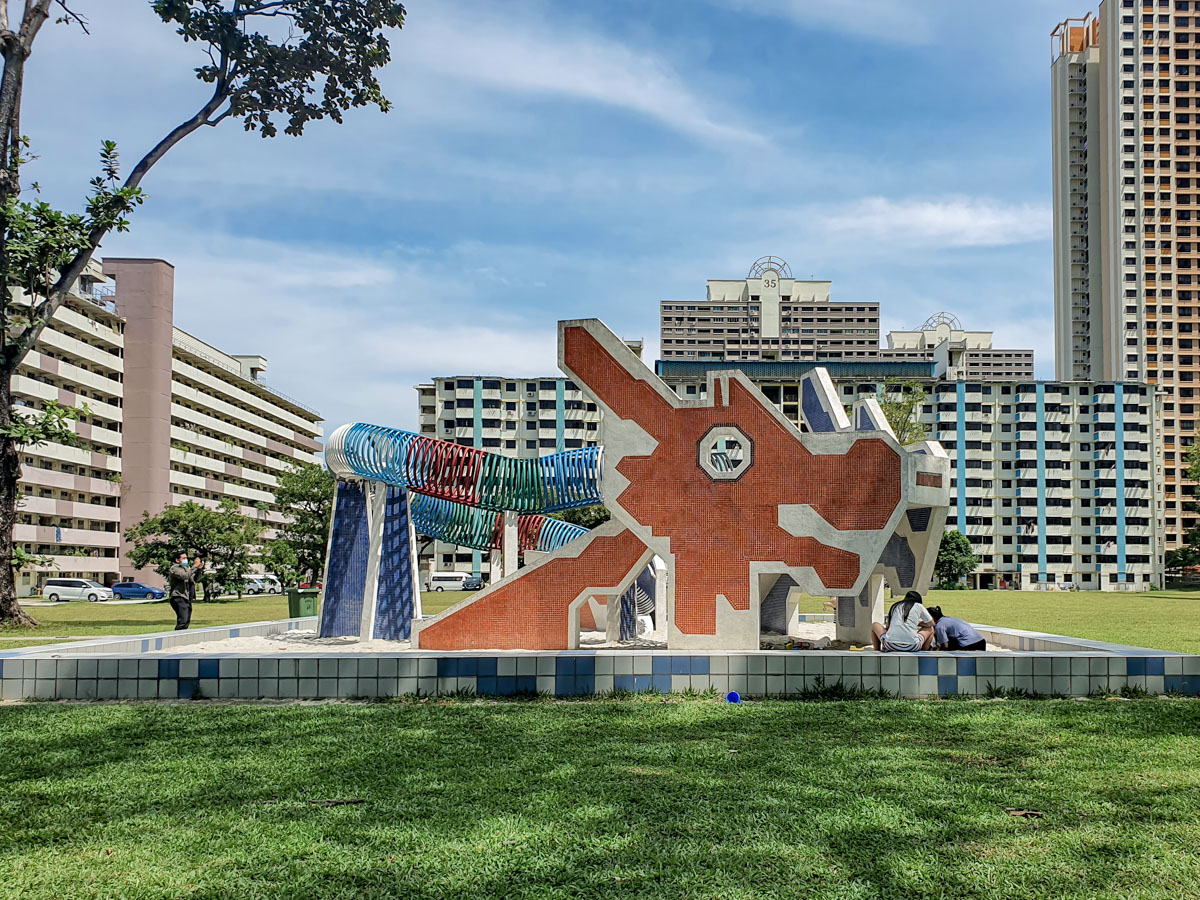All images: Natasha Alvar
I was watching Jennifer Garner’s 13 Going On 30 when I suddenly felt a desire to be on a swing again. In the movie, 30-year-old Jenna Rink revisits an old playground she and her childhood best friend Matt used to play at. The scene reminded me of all the times I had on swings when I was younger.
So I asked my husband to take me to the nearest playground with a swing. I wanted to swing my heart out because there is no greater feeling than being on a swing, adrenaline dancing through your body as you dip your toes into the sun.
But this fantasy proved harder to fulfil than I thought. I remember from my childhood that there used to be numerous swings everywhere. Still, now, as I walk by untouched playgrounds on my way home, with their rubber mats and strange turning tiles you could use to play tic-tac-toe, it felt like those memories were just figments of my imagination.
Where have all the swings gone?
Physical changes
It’s been years since I’ve set foot on a playground, and of course, playgrounds wouldn’t look the way they were 20 years ago. Playgrounds of yesteryear used to be spaces that could accommodate children of all ages simultaneously; I could be on the swing as a pre-teen, and a much younger kid could be playing in the sandbox nearby.
Now, playgrounds are tailored for particular age groups—spaces for ages 2 to 5 would have more low-lying features and fewer sliding poles, while playgrounds for those 5 to 12 would be more complex and include more climbing structures. There are also combination playgrounds that allow for children between 2 to 12 to play together, retrofitted with firm instructions that these spaces are not built for anyone over the age of 12 and that adults need to accompany their children at all times.
More significant changes have occurred, like the switch from sand to Ethylene Propylene Diene Monomer (EPDM). While sand can cushion a child’s fall to an extent, EPDM, a synthetic rubber, is deemed safer since it’s subject to head impact testing.
There are also hygiene concerns when it comes to sand, where the playground becomes a massive litter box for roaming pets and unknown elements that might be buried that could cause injury later. Sand is also a little messier since children playing in the sand might spill some of it onto pavements amid play.
In stark contrast, older playgrounds are made of more rigid materials, such as concrete finished with terrazzo surfaces or mosaic tiles, which can be dangerous if children fall on them. As these materials erode over time, they produce sharp edges, which increases the risk of children getting injured during play.
It’s all about safety
Safety is one big reason why swings are not as much a common feature as they were before. According to Mr Allen Teng, Managing Director of Gorica Asia Pte Ltd, a company designing playgrounds since 1990, Singapore playgrounds abides by SS 457 safety standards. Because of these guidelines, swings require quite a bit of space for operation.
A regular swing set is about 2 metres in height—this means that the safety zone is a cavernous 4 metres in front and behind. Contractors thus need to consider the amount of space available and whether or not swings can be accommodated in their design pitch. With space constraints an issue in our HDB estates, this is probably why we’ve moved away from swings in neighbourhood playgrounds.
Additionally, as part of our transition from the third world to first world country—with one such strategy being the neighbourhood renewal programme—demolition of these playgrounds was inevitable.
While mainly for safety reasons, it also gives the space an aesthetic update since everything around it is rejuvenated.
There are exceptions, of course, such as the Dragon playground in Toa Payoh, which was saved from demolition due to the rallying cry of some individuals who felt that it is essential to safeguard these heritage spaces. This particular playground was also voted one of the 15 most amazing playgrounds worldwide by Flavorwire.com, a New York-based website, so this might have helped the cause.
Still, complete preservation is not always possible, and while the Toa Payoh dragon has managed to keep all its features, a similar one in Ang Mo Kio is now fitted with EPDM flooring instead of sand.
Playgrounds and community
Considering how older playgrounds were preserved due to heritage reasons, it seems that we’ve always looked to playgrounds as symbols of Singapore’s community and identity. After all, Mr Khor Ean Ghee, who designed these playgrounds in the 1970s, wanted these playgrounds to be a series of landmarks reflecting our cultural heritage.
While playground designs are more varied now, we still look at them to build communal harmony. This is facilitated by adding fitness corners beside playgrounds to create intergenerational bonding.
Residents have also been invited to come on board to help design playgrounds. We saw this in 2018 with the start of the Build-A-Playground initiative, where the first resident-designed playground opened in Sembawang Close.
The residents helped design the space and worked together to build the entire play area. The objective here is to create a sense of ownership, so there is attachment to the space and a way for residents to decide what would be best for their community and their children.
The current state of play
On the other hand, our local parks seem to be keeping things a little more old school. If you wanted to find a swing, a park would be your best bet. While HDB playgrounds have more or less moved on from sand, this isn’t the case for our parks, which list sandcastle building as a major attraction—well, in five of them at least.
Still, running to play at the park isn’t quite as convenient as running downstairs to the nearby playground. Going to the park is a family outing; it’s an occasion, maybe something done on the weekends to let the kids have some fun. It’s not practical for day-to-day play.
Growing up, playgrounds were my de-facto babysitters. If my parents had errands to run, they would deposit my brother and me at our favourite playground in Yishun, give us explicit rules of what not to do, and return when they were done. We entertained ourselves well enough and could spend hours envisioning different scenarios to play out in the space.
After school each day, we would rush down to the playground right beside our HDB flat, and our mom would shout at us from above when it was time to head back.
It’s a different story these days. When I spoke to Punggol residents Mr Muhammad Siddiq and his wife Mdm Eisah Latif, both 33 years of age, they mentioned that they always accompany their 8-year-old daughter to the playground. Notices in playgrounds also advise parents to accompany their children for safety reasons.
“It’s important to take note of the surroundings,” Mr Siddiq warns, “we can never take our safety & security for granted.” He added that older children sometimes play ball games at the playground, resulting in potential injury.
More importantly, they look at play as bonding time with their child. Mr Siddiq, a Managing Director of his own freight forwarding company, brings his daughter out for weekly runs. Both parents take the time to do outdoor activities like rock climbing and hiking with her over the weekend.
Ms Lavinia, a 37-year-old educator and mother of three, has a structured way of doing things when it comes to playing.
“I choose outdoor play options for their ability to meet certain criteria. If the purpose for that outing is fitness, then I pick a park or trail that’s kid-friendly to walk. I also ensure there are learning points to bring across, like learning about plants and animals. If the outdoor play is about fun and trying new playgrounds, then I look for parks with unique features like bouldering, cool slides or climbing structures.”
Screens & play
She also noted that screens have inevitably made their way into playtime, especially after the circuit breaker moved many activities online.
“With Home-Based Learning, the kids have learnt how to navigate Youtube and screens by themselves, so we try to limit it to no more than an hour a day. We also curate useful and educational games for them and not hop on trends like Minecraft and Among Us. We have conversations with them about these choices too.”
When asked about how much screen time they allowed their daughter, Mr Siddiq and Mdm Eisah were quick to emphasize how strict they are when it comes to playtime with screens.
“Nowadays, be it social media or even television, there are more negative than positive content available,” Mdm Eisah shared. “And too much screen time, be it on TV, handphones or iPads, can also affect children’s eyesight; we see so many young children wearing spectacles already. It’s very common to see parents nowadays giving their kids phones to play with whenever they are throwing a tantrum. But in reality, they are spoiling them in the long run.”
Ms Wong, a 34-year-old former educator raising her two sons aged 3 and 1, is on the other side of the fence. She reflected that she does try to stick to the recommended guidelines of 1 hour of screen time per day. However, there are days when guests come over or need to get chores done, so the children spend more time with screens to keep them occupied.
When I asked about screens in playtime to 22-year-old pre-school educator Ms Athirah, she said they aren’t part of things just yet. For her, play is a spontaneous and free space for the children.
“I do not have a specific plan for the children’s playtime as their playtime is free play. I let the children lead and plan what they want to do. However, at times, while hearing their conversations with one another, I get ideas of how they can make their play more meaningful and using that, I spontaneously plan a play activity for them to do.”
She added, “For the children’s outdoor play, I often rotate between the playground and other outdoor activities. The children usually play at the playground twice or thrice a week. We also try to conduct games at the playground so that their playtime could be meaningful and engaging.”
When asked about the future of playgrounds, Mr Teng spoke about the inclusive playgrounds the company has constructed in the past few years.
“The latest playground we built for Cerebral Palsy Alliance Singapore (CPAS) school has a wheelchair-accessible merry-go-round, with the playset also incorporating wide wheelchair accessible ramps for users of all abilities. There’s also a swing for wheelchair-bound users, with fences surrounding the swing for safety.”
Mr Teng also hopes to have more interactive play elements in playgrounds of the future, such as features using kinetic energy to generate sound.
But as children move through the various phases of pre-school education, will they still have time for play?
The future of play(grounds)
Using the kindergarten programme for a child going to PCF Sparkletots as a baseline, it’s undoubtedly more rigorous and academic-focused compared to how things were back in the early 90s. If both parents are working full time, the child would be in school from 7 am to 7 pm, with most of the time devoted to literacy, numeracy, and the mother tongue curriculum.
Kids who go to kindergartens now are being prepared for their academic life in primary school. When they get there, they already know the basics of their core subjects.
“It’s not a flood of assessment books or anything but like thematic teaching with field trips, learning activities and games to reinforce learning of certain words and challenging them to read. The teachers used many hands-on activities to teach and build on their creativity. To build fine motor skills, they bake and knead dough. To build dexterity, they climb monkey bars. I like this hands-on element. Kids sometimes may be wary of doing this at home with us but are quite excited to do it when there are friends around.”
Play is still very much a part of things now as it was before, just repackaged with a greater sense of structure and a firm set of routines.
Adults and play
In the end, I had to travel all the way to Pasir Ris Park to find a swing set that would accommodate my adult-sized body. As I swung away, my husband diligently waiting for me to be done with my mad whim, I noticed all the adults looking my way. I couldn’t tell if it was looks of envy or worry that the swing might break under my weight – they were all masked up, and it’s hard to read facial cues when the world feels like it’s flying by.
While being on the swing was still the most amazing thing, it didn’t feel the same anymore. Maybe it’s because this isn’t a playground in my neighbourhood, or that EPDM flooring doesn’t feel quite the same as sand getting caught in your toes. The real reason? Maybe play just isn’t part of the fabric of things anymore, at least not when you’re an adult.







